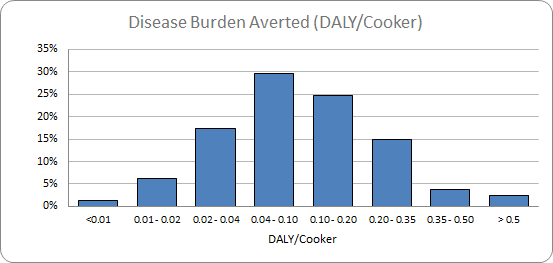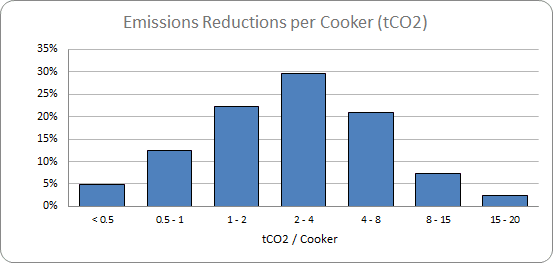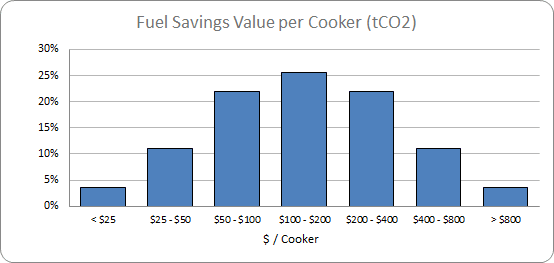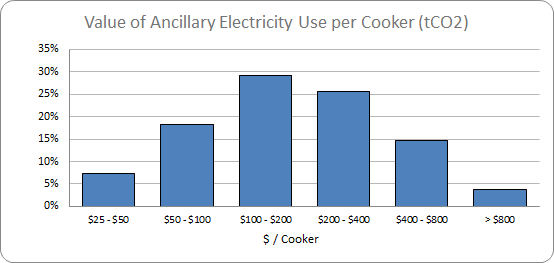SUMMARY: This post provides an exploratory analysis of the cost-effectiveness of off-grid solar-electric cooking in rural Africa with a focus on Malawi. If implemented efficiently, this intervention is likely to improve health outcomes typically at a rate of 0.1 DALY/cooker for small cooking systems and in some situations may be able to provide benefits as high as 1.5 DALY/cooker for large cooking systems in countries with a high indoor air pollution burden of disease. The use of a solar-electric cooker can also reduce CO2 emissions, by about 3 tons of CO2 /cooker in rural Malawi. A customer-owned off-grid electricity supply for a small cooker system generates cost-savings for the owner that are likely to be about $300 to $400 per cooker system on average over the lifetime of the cooker. Whether these economic benefits of long-term cost savings are sufficient to convince rural Malawian households to invest $150 to $300 in the off-grid electricity supply system that is needed for solar-electric cooking remains to be seen
Introduction
As mentioned in our previous post, Solar4Africa’s Project #4 aims to assess the possible humanitarian benefits that the adoption of long-lasting solar electric cooking systems has on communities in rural Malawi. By replacing biomass sources such as firewood or crop residue for cooking, offgrid solar electricity provides the opportunity for cleaner, cheaper and longer-lasting energy. Several years of research and development for this project has been undertaken with generous support from the Modern Energy Cooking Services program of UK Aid.
Our project’s goal is to distribute philanthropically-supported offgrid cooking systems to women’s groups and households that are efficiently subsidized. A subsidy is “efficient” if the intervention enabled by the subsidy generates benefits that outweigh the initial subsidy cost of the cooking system. In the current post, we value of social, economic and environmental benefits from an EA perspective. This post, described how for global health and welfare (GHW) interventions the value of an avoided DALY of disease burden ranges approximately from $50 to $125, while the value of a percent of income increase for one year for one person is valued at about $0.25 by EA GHW charities.
The current post aims to outline our final cost-effectiveness analysis of solar-electric cooking by focusing on the health & monetary benefits, and will detail our justification for continuing the implementation of our intervention.
This analysis should be generally relevant to interventions that assist low-income households to switch from wood-based and charcoal-based cooking to solar electric cooking. For the interventions specifically used by Solar4Africa, currently an affordable solar electric cooking system does not yet have enough capacity to satisfy the entire cooking needs of rural Malawian households and currently satisfies approximately ¼ of household cooking needs.
Health benefits of solar-electric cookers
Solar-electric cookers require no “solid fuel” in order to cook food and have no direct pollutant emissions, thus their use in cooking all of a household’s food should mitigate almost all of a household’s indoor air pollution caused by indoor biofuel fires. Currently, the vast majority of the population in Malawi currently uses charcoal and wood to prepare food and thus has a disease burden from this risk that is much higher than for countries where people cook with gas or electricity. According to VizHub’s Global Burden of Disease 2019 data, the disease burden of “Household air pollution from solid fuels” for Malawi is estimated at an average of 3401.98 DALY/100,000 people with a range of 2515.77 to 4459.86 per 100,000 people. This would mean that the use of solar electric cookers could avoid from 0.0252 to 0.2230 DALYs/year in Malawi with an average health benefit of 0.0988 DALY/year/cooker of avoided disease burden as shown in the following Table 1, depending on how many beneficiaries are impacted by the use of clean cookers:
Table 1: Matrix of expected health benefit values
| Beneficiary/Household | DALY/Beneficiary/yr (Low) | DALY/Beneficiary/yr (Med) | DALY/Beneficiary/yr (High) |
| 1 | 0.0252 | 0.0340 | 0.0446 |
| 3 | 0.0756 | 0.1020 | 0.1338 |
| 5 | 0.1260 | 0.1700 | 0.2230 |
Solar4Africa works in Malawi. For a Sub-Saharan African (SSA) country, Malawi has an “average” burden of disease due to household air pollution from solid fuels. Some countries in SSA (e.g. Mali, Burkina Faso, Niger, Chad, Central African Republic) have about twice the burden of disease from household solid fuel use as Malawi. For larger households in such countries, a health benefit of approximately 0.5 DALY/year may be obtained by fully switching to clean cooking technologies like solar electric cooking.
We also recognize that women are disproportionately affected by household air pollution from solid fuels because they are often the household member that prepares the food while men are out working. However, the Global Burden of Disease data is an average of all Malawi citizens and thus takes into account both men and women’s exposure to pollution caused by indoor biomass fires. It is also important to note that Solar4Africa’s solar-electric cookers are limited to cooking only roughly ¼ of a household's food and the rest must be prepared traditionally with disease-burdened biomass fires. In our CE calculations we take this into account by multiplying the disease burden averted by “Percent Impact” which is the fraction of the household indoor air pollution disease burden averted by the clean cooker. In specifying the percent impact, the low estimate being 10% mitigation, the medium estimate being 20% mitigation, and high estimate being 30% mitigation. (Note: there is large uncertainty in the relationship between marginal exposure to indoor air pollution and marginal health impacts. There is some evidence that at the margin, that benefits of pollution reduction may be smaller than what would be assumed from a linear, exposure/health relationship).
Climate benefits of solar-electric cookers
We also note that the use of solar-electric cookers will lower CO2 emissions. This is due to the fact that utilizing solar cookers in Malawi will reduce dependency on wood as a fuel source. This will decrease wood burning which will have many positive benefits on the environment, particularly the reduction of unsustainable harvest. The percentage of wood that is harvested unsustainably is the percentage of wood that does not grow back. The continued practice of unsustainable harvest will lead to an overall rate of wood harvest exceeding the rate of wood growth. This fosters deforestation and increases in CO2 emissions. In Malawi specifically, this study estimates the percentage of wood that is harvested unsustainably ranges from 24.2% to 41%. Furthermore, the same study estimates that on a global scale, unsustainable harvest accounts for roughly 1.9-2.3 percent of global emissions.
Additionally there are multiple hotspots around the globe where the percentage of wood that is harvested unsustainably is large. These areas include East Africa, Western and Southern Africa, and parts of Asia. A hotspot is defined as an area in which FNRB (fraction of non-renewable biomass) exceeds 50 percent. It is these hotspots that contribute most to the problem of unsustainable harvesting. Since Malawi is in East Africa, this means that it is in a hotspot region.
Cost effectiveness (CE) calculations
There are multiple and diverse benefits from solar-electric cooking as a replacement for wood-based and charcoal-based cooking. In addition to the health and climate-related benefits mentioned above, there are financial savings from decreased expenditures on cooking fuel, and there are benefits from ancillary uses of the solar electricity for lighting, phones charging and electronics (i.e. audio equipment and TV).
For each of the four benefit categories, we provide in turn our best preliminary estimate of the benefit per cooker for the four different types of benefit. We don't estimate simply a single value for cooking benefits, but a probability distribution of expected benefits that reflect the uncertainty in the input parameter values used in the benefit calculation.
Disease burden mitigated per cooker
As described above the mitigated disease burden from a solar electric cooker depends on the baseline disease burden from “Household air pollution from solid fuels.” We use the range of values representative for Malawi. For several countries in SSA, these values are about twice as high. The number of household members benefitting from the disease burden reduction is likely conservative, as the baseline disease burden values are a population average. The potential cooker lifetime is estimated to range from 3 to 10 years.
Table 2: Inputs for health benefit estimation
| Variable | Low | Med | High |
| Disease Burden per Ben. | 0.025 | 0.034 | 0.045 |
| % Impact | 10% | 20% | 30% |
| # of beneficiary/HH | 1.0 | 3.0 | 5.0 |
| Cooker Lifetime (years) | 3.0 | 5.0 | 10.0 |
Figure 1: Estimated distribution of disease burden reductions for a solar electric cooker that is used for approximately ¼ of household cooking needs.
Figure 1 illustrates the range of expected disease burden reductions that may be expected from a cooker that is used for ¼ of cooking. The median value is approximately 0.1 DALY/cooker, and may be as high as 0.2 to 0.5 DALY/cooker for cookers in areas with a larger indoor air quality disease burden than Malawi and when a a 20% to 30% reduction in solid cooking fuel indoor ir quality disease burden occurs for all household members. For Effective Altruists that value 1 DALY of disease burden reduction at a bit more than $100, this is worth about $10 for the median Malawi case and can be worth $20 to $50 in high impact applications. A full switch to solar electric cooking in a high solid fuel cooking burden of disease (>0.06 DALY/capita/year) location for households with 5 or more members would likely create more than 1.5 DALY of reduced disease burden per cooker system which should be worth more than $150 from a EA perspective.
CO2 emissions reduction per cooker
The CO2 emissions reduction per cooker depends on four key input parameters: (a) the daily usage of the cooker (measured in kWh/day), (b) the wood fuel equivalent emissions reduction per kWh solar electric cooking,(c) the fraction of wood harvested that is harvested unsustainably, and (d) the lifetime of the cooker.
To determine the daily use, Solar4Africa has measured the actual daily use of the cookers under actual customer conditions. For the emissions per kWh, Solar4Africa has measured in parallel cooking tests, that 1 kWh of electric cooking uses either 2 kg of wood or 1 kg of charcoal using traditional cooking methods. Since 7 kg of wood is required to make 1 kg of charcoal, this mean that 1 kWh of electric cooking is equivalent to 2 kg to 7 kg of wood. With an emissions factor of 1.8 kg CO2/kg wood this is 3.6 to 12.6 kg CO2. The fraction of unstainable harvest and cooker lifetime are explained above.
Table 3: Inputs for CO2 emissions reduction estimation
| Variable | Low | Med | High |
| kWh/day of Use | 0.30 | 0.60 | 1.00 |
| Total kgCO2 / kWh | 3.6 | 8.1 | 12.6 |
| % Unsustainable harvest | 24.2% | 32.8% | 41.4% |
| Cooker lifetime (years) | 3.0 | 5.0 | 10.0 |
Figure 2: Estimated distribution of CO2 emissions reductions reductions for a solar electric cooker that is used for approximately ¼ of household cooking needs.
Figure 2 illustrates the probability distribution of emissions reductions per cooker. The key reason that the emissions reduction per cooker has a relatively low median value of 3 tons of CO2/cooker is because ⅔ of wood harvested in Malawi is estimated to be replaced by new growth, thus only about ⅓ of short-term emissions reductions actually has a long-term climate benefit.
Fuel savings value per cooker
Because we know the equivalent wood and charcoal use associated with 1kWh of cooking, given the per kg cost of wood and charcoal, we can estimate the value of the wood are charcoal does not have to be purchased when one uses the electric cooker. As mentioned above, the amount of biofuel saved from electric cooking is either about 2 kg of wood or 1 kg of charcoal. Wood can have a price as low as $0.025/kg (because some can be gathered from around the household for free) and charcoal has a price in Malawi of about $0.35/kg. Table 4 summarizes the input parameter ranges for the fuel savings value calculation.
Table 4: Inputs for fuel savings value estimation
| Variable | Low | Med | High |
| kWh/day of Use | 0.300 | 0.600 | 1.000 |
| $ Fuel Savings Value /kWh | $0.05 | $0.15 | $0.35 |
| Cooker Lifetime (years) | 3.0 | 5.0 | 10.0 |
Figure 3: Estimated distribution of fuel savings cost reductions for a solar electric cooker that is used for approximately ¼ of household cooking needs.
Figure 3 illustrates the probability distribution of the fuel savings value of the cooker energy that is used. Note that the median value is slightly less than $200 per cooker. This value is substantial, but because it accrues over 5 years on average, it may not be enough on its own to convince rural Malawian households to make the $150 to $300 investment that may be needed for such an off-grid electricity supply system.
Other potential benefits
Solar4Africa.org is implementing an off-grid version of solar-electric cooking. Thus the acquisition of a solar electric cooker is associated with the acquisition of solar panels and some equipment that can also be applied to other off-grid end-uses such as lights, phone charging and household electronics (i.e. audio equipment and TV). While only a relatively small amount of electricity is used for such ancillary applications per day, the value of such electricity is much higher than the value of electricity used for cooking, because the cost of batteries and alternative electric systems designed for lighting and electronics have a much higher per kWh cost of service provision (i.e. $0.5 to $2). Table 5 lists the input parameter values and their ranges for estimating the benefits of ancillary electricity use that may be provided by the electricity supply system of a solar-electric cooker.
Table 5: Inputs for estimating value of ancillary electricity use
| Variable | Low | Med | High |
| kWh/day of Ancillary Use | 0.050 | 0.100 | 0.200 |
| Ancillary Use Value /kWh | $0.50 | $1.00 | $2.00 |
| Cooker Lifetime (years) | 3.0 | 5.0 | 10.0 |
Figure 4: Estimated distribution of ancillary electricity use value for a solar electric cooker system that is used for approximately ¼ of household cooking needs.
Figure 4 illustrates the economic value of ancillary electricity uses that may be served by the off-grid solar power system providing electricity to a solar-electric cooker. While the median value is about $200, a substantial number of households may benefit by $400 to $800 from the ancillary uses of a solar-electric cooking system. This may provide a very strong motivation for many households to invest in the electricity supply system that can also power an off-grid solar electric cooker. Solar4Africa has seen this reflected in customer purchase behavior with respect to solar panels and cookers in rural Malawi. Many households will purchase a large solar panel in order to have more reliable electricity for ancillary uses, but because the ancillary uses use only a fraction of the solar panel’s electricity most of the time, the rest of the solar panel electricity is available for cooking.
Conclusion
We recognize that the data shows the solar electric cookers typically will have a relatively small impact on health and climate. In Malawi, the cooker health benefits are likely to average around 0.1 DALY/cooker of reduced disease burden, while the climate benefits represent about 3 tons of CO2 emissions reductions per cooker.
However, even though the health and climate benefits are small, they may still be significant. Rural Malawians typically anywhere from $200-$500 per capita per year, and the cookers can cost the beneficiaries as little as $30-$50 if efficiently distributed. Thus the benefits generated from the cookers are enough to roughly offset the cost of the actual cooker itself.
An off-grid cooker system also requires a solar-electric battery and solar panels that are also distributed by Solar4Africa, and while the costs of these products are not usually fully offset by the climate benefits of electric cooking, the value in the off-grid solar electric power supply can offset by the long-term value of the electricity it produces. The value of the electricity used varies by what the electricity is used for. If the electricity is used to displace the use of wood and charcoal, the value ranges from $0.05/kWh to $0.35 per kWh. If the electricity is used for lights, phone charging and electronics (i.e. ancillary uses), its value can range from $0.50 to $2.
For both cooking energy use and ancillary electricity use, the median value of the electricity generated and used by electricity supply system is slightly less than $200 over the lifetime of the cooker. This means that the value generated by off-grid electricity supply system is expected to be about $300 to $400. The electricity supply system is likely to cost between $150 to $300. But what is perhaps more important, is that a substantial fraction of customers can obtain more than $400 in value from ancillary electricity uses from a large solar panel that supplies electricity for both cooking and ancillary uses. Solar4Africa has found anecdotally that these customers are willing to buy large solar panels that can supply both cooking and ancillary uses, and are willing to buy the cooker in addition to the solar panel if the cooker is subsidized.
With all of this in mind, we believe that there are enough benefits being generated from Solar4Africa’s Project #4 to continue work. Thus Solar4Africa.org will continue the implementation of this intervention where if the customers can invest in the solar power supply (perhaps because of ancillary electricity uses), it may be cost-effective to subsidize the addition of a solar-electric cooker. Moving forward, we aim to present the benefits of our solar-electric cookers to policy makers to help encourage the government of Malawi to implement efficient policies with respect to clean cooking. For example, allowing the importation of electric cookers at a subsidized (or even tax-free) rate which would ultimately lower the cost for beneficiaries and could cost-effectively generate social and environmental benefits described in the current post.




